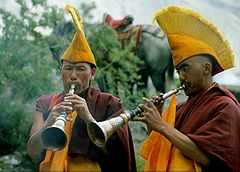Lingshed Monastery
| Lingshed Monastery | |
|---|---|
 Lingshed Monastery | |
 Lingshed Monastery Location within India
| |
| Coordinates: | 33°54′11″N 76°49′10″E / 33.90306°N 76.81944°E |
| Monastery information | |
| Location | Zanskar, Ladakh, Jammu and Kashmir, India |
| Founded by | Kyabje Dagom Rinpoche |
| Type | Tibetan Buddhist |
| Sect | Gelug |
| No. of monks | 60 |
Lingshed Monastery or Lingshed Gompa is a Gelugpa Buddhist monastery in the Zanskar region in the state of Ladakh in Jammu and Kashmir in northern India. The Jangchub Tensung Dorje Center was founded in Lingshed by Kyabje Dagom Rinpoche.
The ceremonial life of Lingshed Monastery and its monks is the subject of Identity, Ritual and State in Tibetan Buddhism (Routledge 2003) by the anthropologist Martin A. Mills.[1]
History
Lingshed Village, at the heart of the Trans-Sengge-La region between Ladakh and Zanskar, has been inhabited for nearly a thousand years. It was originally reputed to be a local hunting area, which is the source of its name. The village has been the site of several Buddhist monasteries: the remnants of a cave monastery and two walls dedicated to the translator Rinchen Zangpo (958–1055). Local tradition in the region also speaks of Kadampa and Drugpa Kagyu monasteries in the valley.[2]
Lingshed Monastery (or Kumbum, meaning 'A Hundred Thousand Images') was founded as a Geluk School Monastery in the 1440s by Changsems Sherabs Zangpo, disciple of the noted Tibetan preceptor Je Tsongkhapa. Local tradition records how Sherabs Zangpo, having founded Karsha and Phugtal Monasteries to the south, travelled over Hanuma-La Pass to the south of Lingshed, from where he saw an 'auspicious shining light' shining on a rock on the hillside. He built a chorten around that rock, and this became the basis of Kumbum's central shrine, Tashi 'Od Bar ('Auspicious Shining Light' shrine).[3]
In 1779, the Ladakhi king Tsewang Namgyal donated the lands of Lingshed and its surrounding villages (along with the Zanskari monasteries and villages of Karsha, Mune, Phuktal and Rangdum) to Lobsang Gelek Yeshe Dragpa, the 3rd incarnate of the Ngari Rinpoche lineage. In 1783, Ngari Rinpoche founded Rangdum Monastery on the boundary of the Karsha Valley as his ecclesiastical seat, to which Lingshed is subordinate.
Description
| Part of a series on |
| Tibetan Buddhism |
|---|
 |
|
Key concepts
|
|
Key figures |
|
Practices and attainment |
|
|
|
The monastery houses about 60 monks and is on the route between Zanskar and Lamayuru. It serves the surrounding villages of Lingshed, Skyumpata, Yulchung, Nyeraks, Dibling and Gongma.[4] The monastery consists of six principal shrines, kitchens, store rooms and - on its uppermost floor - an apartment for Ngari Rinpoche or other visiting high lamas. Below the central temple complex, monastic quarters (shak) fan out in long lines. Lingshed monastery also maintains outlying shrines in each of the villages it serves.

It is marked on an early survey map as 'Linshot' and is four marches south of Khalatse. There were two sons of La-chen-Bha-gan (c. 1470-1500 CE), the third king of the Second West Tibetan Dynasty. The younger son had the eyes of his elder brother, Lha-chen-Lha-dbaṅ-rnam-rgyal (c. 1500-1532), put out and then he took the throne. "Still, for the continuance of the race, he stationed him, together with his wife at Liṅ-sñed" where his wife bore three sons.[5]

Footnotes
- ↑ Martin A. Mills, 2003. Identity, Ritual and State in Tibetan Buddhism: The Foundations of Authority in Gelukpa Monasticism. London: Routledge.
- ↑ Mills, M.A. 1996. Notes on the history of Lingshed Monastery, Ladakh. In Ladakh Studies 8. Journal for the International Association for Ladakh Studies; ISSN: 1356-3491.
- ↑ See Mills 2003: 20.
- ↑ Rizvi (1996), pp. 250-251.
- ↑ Francke (1926), pp. 102-103.
References
- Francke, A. H. (1926). Antiquities of Indian Tibet. Vol. II. First edition 1926. Reprint 1972. S. Chand & Co. (Pvt.) Ltd., New Delhi.
- Mills, M.A. 1996. Notes on the history of Lingshed Monastery, Ladakh. In Ladakh Studies 8. Journal for the International Association for Ladakh Studies; ISSN: 1356-3491.
- Mills, M.A. 2003. Identity, Ritual and State in Tibetan Buddhism: The Foundations of Authority in Gelukpa Monasticism. London: Routledge.
- Rizvi, Janet. 1996. Ladakh: Crossroads of High Asia. Second Edition. Oxford India Paperbacks. 3rd Impression 2001. ISBN 0-19-564546-4.
External links
| ||||||||||||||||||||